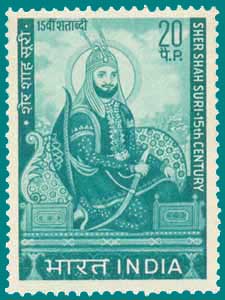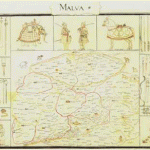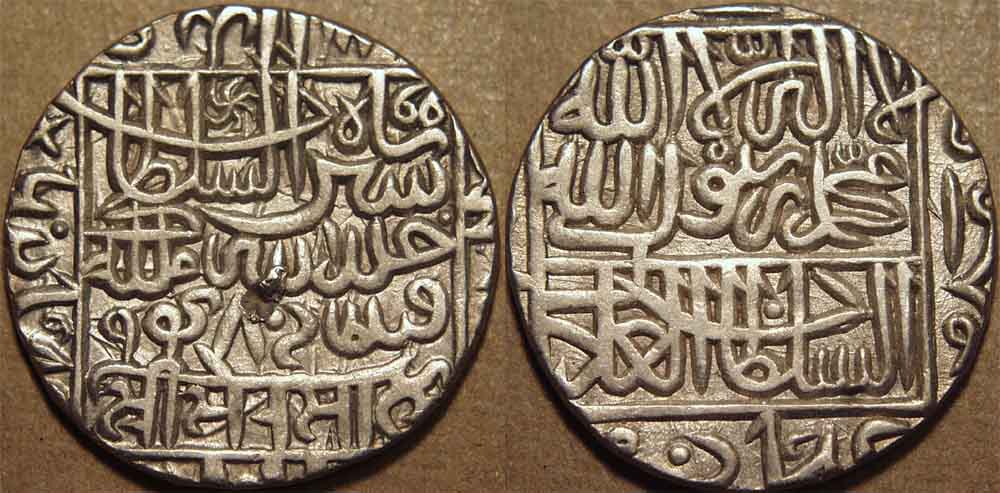 SHERSHAH
SHERSHAH[1486--1545]
NO GOVERNMENT HAS SHOWN SO MUCH WISDOM AS THIS PATHAN
--------------- KEENE
Farid Khan was one of the eight sons of Mian Hassan Khan Sur who worked for the lodi sultans during the sultanate regime in Delhi. He belonged to the Pasthun sur tribe (prominent tribe of Afghanistan). The lodi sultans were impressed by Farid Khan's grandfather, Ibrahim Khan Sur's valour and took his help in conquering Jaunpur. Thus the Surs moved into Indian plains.For their services the sur dynasty were given the Jagir of Sasaram in Bihar under the control of Jaunpur. (Now Jounpoor in present day uttar pradesh; NH 56 passes through it)
Farid Khan had a step mother whose intrigues compelled him to leave his father's protection.He served Jamal Khan the governor of Jaunpur. Despite his father's requests and the governors persuasions Farid stayed back and became well versed with persian literature. During the same time he learnt the administrative as well as the war strategies. Soon he became well posted in persian literature. For a time he was reconciled with his father who allowed him to return to Sasaram and administer the jagir. He did his work so well that his grand mother grew jealous of his popularity and he was compelled to leave again.
In 1522 Farid took service under Bahar Khan Lohani the ruler of Bihar. Legend says that Farid Khan single handedly killed a tiger for which his master called him Sher Khan and appointed him as the tutor of his minor son. But the intrigues of his enemies compelled him to leave Bihar. He joined the new invader of India, Babar the moghul. His abilities were appreciated by Babar who restored to him his ancestral Jagir, sasaram. In the mean
while the ruler of Bihar died. Assuming the guardian ship of the son of ruler of Bihar, Jalal Khan,Sher khan left the Moghuls. No sooner he became the defacto ruler of Bihar. Jalal Khan unable to digest Sher khans rise requested the king of Bengal to oust Sher Khan. A war followed and Sher Khan inflicted crushing defeat on the combined armies. He became the new king of Bihar.
From Sher Khans journey continued without any hiccups. He conquered Bengal and forced its ruler to his submission. Later he conquered Gaur, Chunar, and defeated the Mughal emperor Humayun(son of Babar) at Chausa. Humayun escaped narrowly(1539) .The Entire Mughal empire was now under his control. Humayun tried to regain but suffered a crushing defeat in the hands of SherKhan.(1540). Assuming the title Sher Shah, he ascended the throne of Delhi.
Sher Shah ruled Delhi for a period of five years. All those years he was continuously at war with loyal states of Humayun, Rajputs, as well as his own jealous Afghans. The Rajputs showed tremendous courage and tormented Shershah for a long while.
What distinguishes Sher Shah from others is his administration and statesmanship. He was the first Indian ruler to design a road map for the entire country.(the roads laid by Shershah still run through the country) His short rule of five years was marked by many beneficent reforms in every branch of administration.He provided the next gen rulers a thorough land revenue system. For the first time he introduced a regular postal service in India. In short he laid the foundations for Modern India.
Great as a conqueror Sher Shah was greater still as a ruler. Sher Shah had set up such a fine administration that the great Mughal king Akbar retained most of it, and Sher Shah's administrative set up was largely how the Mughal empire's administration remained for a long time.
Sher Shah's currency reform deserves high praise. He issued a large number of silver coins (dam) and abolished all old and mixed metal currency. His silver rupia after elimination of its inscription .was current till 1835 and formed the basis of the later British Indian currency. The system of tri-metal ism which came to characterize Mughal coinage was introduced by Sher Shah. While the term rupya had previously been used as a generic term for any silver coin, during his rule the term rupiya came to be used as the name for a silver coin of a standard weight of 178 grains, which was the precursor of the modern rupee. Rupee is today used as the national currency in India, Pakistan,Nepal, Sri Lanka, Indonesia, Mauritius, Maldives, Seychelles, among other countries.Gold coins called the Mohur weighing 169 grains and copper coins (paisa; 40 paisa = 1 dam) were also minted by his government
He improved communications by building many high roads which linked up he different parts if his empire. These Roads were lined with trees and wells and rest houses(sarais) were constructed on the road side for the convenience of travellers both Hindu and Muslim. The most famous grand trunk road which ran from sonargaon (now in Bangladesh) to the Indus( our NH1). Other important roads include road from Agra to Multan via Burhanpur and Delhi; road from Multan to Lahore; and road from Mandu to Agra. His road vision helped in installing the postal system in India.His multi-front crusade began with building 3000 miles of communication network, complete with milestones, connecting the capital, Agra with outlying areas
In the short span of a 5-year rule (1540-1545), Sher Shah Suri established the foundations of a mounted post or horse courier system, wherein conveyance of letters was also extended to traders. This is the first known record of the Postal system of a kingdom being used for non-State purposes, i.e. for trade and business communication. Sher Shah’s administrative reforms were so well integrated with the postal system, that it rightly earned the place of the first officially recorded mounted post in India ..The existing dak runner system was revamped, with two horse couriers stationed at every 2 mile-distance for speedy conveyance of official and trade correspondence. A total of 1700 post houses with 3400 postal messengers have been recorded.The sarais(rest houses )and dak chawkis(post-houses) dotting the route were overhauled to serve the needs of Hindus and Muslims alike. Sarais were more in the nature of inns, serving traders, travellers and officers of the government. The dak chawkis served as transitory points for changing post-horses. Often these sarais doubled up as dak chaukis. These sarais were maintained from the land revenue collected by dak employees from the neigbouring areas, and were self-sustaining.A porter , stationed at each of the post houses, attended to the post-horses and oxen of travellers as well as the needs of post-messengers. A watchman-in-charge) looked after each post-house. Additionally, there were two tariqh navis or post-house clerks, who recorded the arrival and departure of the mail carriers. Mails were carried by mewras and messengers, who were essentially of tribal origin or belonged to the lower castes
Sher Shah also re-organized tariffs and duties to facilitate the development of commerce.. He promoted the cause of trade and commerce by reducing the number of the customs duty collection points to just two. Goods produced in Bengal or imported from outside had to pay customs at Sikrigali, at the border of Bengal and Bihar, while goods from West and Central Asia paid customs duty at the Indus. He promoted the cause of trade and commerce by abolishing many vexatious internal customs. Abolishment of taxes that were a barrier to free trade, brought about development of trade. Introduction of the Rupayya or rupee coin in place of “Tanka” and “Jeetal” and the system of custom duties, gave a fillip to trade and commerce. The consequential increase in business correspondence was facilitated by the large network of roads built during the reign of Sher Shah Suri. The revenue and agricultural reforms of this period will also be of interest to the students of fiscal history
Sher Shah Suri’s reforms devised a practical approach to administration, whence the system of provinces was replaced with Sarkars, Parganas and villages. This was adopted by the subsequent Mughal and British colonial administration. The empire was divided into 47 provinces, called Sarkars (19 in Bengal). Each Sarkar was further divided into smaller districts called Parganas. Each Sarkar was managed by two officers, the Shiqdar-i-Shiqdaram (Military Chief) and the Munsif-i-Munsifan,(Chief of Justice), who oversaw the work of Pargana officers, namely the Shiqdar (administrative officer), Amin (revenue officer), Munsif (judicial officer), Patwari (keeper of land revenue records), Chowdhury (landholder, next to zamindar rank) Muqaddam (village headman), Qarqun (accountant), Mushrif (holder of trust) and Khazaanchi (treasurer). While the Fautedar maintained property records in both, Persian and Hindi, the Qanoongo in each Sarkar supervised the same.The officers were transferred every two or three years to prevent misuse of office, which was an innovation in that epoch of time. It maybe noted that the postal system was still not open to general public, though one comes across references to malpractices involving covert transmission of messages, besides transactions involving land. This is probably the reason that the practice of transferring officers was adopted.
Though military intelligence continued the use of spying as a tool, military matters were however isolated from political and social issues of the empire. The same sarais that served as post-houses, also served as centres of local intelligence gathering.He maintained personal contact with soldiers.
He maintained a strict vigil with effective net work of spies. He checked all sorts of corruption. He dealt out even handed justice to the high and low and with him there was no pleading of privilege and peerage.
Shershah followed an enlightened policy of toleration. He employed Hindus in important offices of the state. One of his best generals was a Hindu named Bramajit Kaur.
Thus Shershah suri establishes himself above all the medieval rulers. In fact he served India in a great deal by a great vision. In fact with limited resources and of course limited TIME he built what he visualized. Its his wisdom that served the country in lots of ways. Almost all rulers survived with his wisdom. Even the great English administrators ran through his chronicles to get the land details and used his road map to drain India.
No doubt, so many of you may have never heard of this great man. But look at his administration. When ever you hear rupee remember its Shershah who coined the word. Whenever you travel on highways of North India remember its the vision of this great man.The Indian posts owe a lot to him. He was the first Muslim ruler who understood secularism to core. He was the first and last ruler to date who understood farmer and his rights.His able administration in books today has lot of solutions to most of the problems we face today.
Its believed Akbar deputed Abbas Khan Sarwani, a waqia-navis to write Tarikh-i-Sher Shahi (history of Sher Shah) dating 1580 CE, is a historical work detailing the rule of emperor Shershah Suri. The work was commissioned by emperor Akbar to provide detailed documentation about Sher Shah's administration. The following is a letter written by a loyal officer expressing sadness over the destruction of empire to Jahangir.
Specially Sher Khan was not an angel (malak) but a king (malik). In six years he gave such stability to the structure (of the empire) that its foundations still survive. He had made India flourish in such a way that the king of Persia and Turan appreciate it, and have a desire to look at it. Hazrat Arsh Ashiyani (Akbar the great) followed his administrative manual (zawabit) for fifty years and did not discontinue them. In the same India due to able administration of the well wishers of the court, nothing is left except rabble and jungles...
“
”
Mirza Aziz Koka, son of Ataga Khan, in a letter to Emperor Jahangirr
We have a habit of honouring people on birthdays alone. We also have a habit of remembering the great kings in story books gifted to children. No academic brain in this country tries to bring in the the greater innovations our past rulers have attempted to save people from misery. This is not an attempt to glorify a ruler. This is an attempt to put forward what we should teach children. This is an attempt to tell how administration can be meaningful.
Today we have resources. A great technology to assist us. Lots of intellectuals in every bend and corner. We have a better administrative system(shershah is an autocrat). Yet our rulers fail to achieve at least 1% of what Shershah achieved in a time span of five years.
Sadly we only have a great past
Sadly we only have a great past
SOURCES:
1) LOT OF HISTORY BOOKS
2)WIKIPEDIA
3) INDIAN POSTS
4)GOOGLE IMAGES
5)MY MOTHER WHO FIRST INTRODUCED ME TO SHER SHAH IN 7 TH CLASS;
6) STAMPSOFINDIA.COM












.jpg)

Captivating!
ReplyDeletegreat job
ReplyDeleteHe was a great ruler and did excellent administrative reforms, this I knew but you have given great information about this great man ( Real ruler ). Thanks!
ReplyDeletesher shah's administration
ReplyDelete